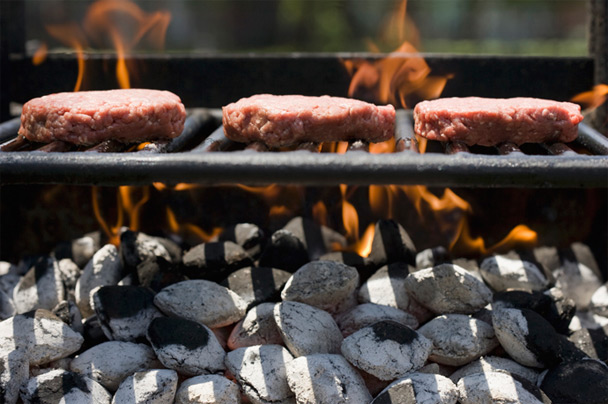There is no shortage of tips for the perfect grilled steak, chicken breasts, or burgers. There is also no limit to the number of techniques for making the best ribs, brisket, or pork shoulder. But when it comes time to fire up the grill, the key to the best flame–kissed flavor is to understand the science behind those tips and tricks. Only then are you free to adapt them to any situation and to become the ultimate grilling geek.
Grill geeks are first and foremost obsessive about temperature. You can take your pick from grill thermometers, instant–read digital meat thermometers, infrared thermometers, and computer–monitored thermocouples. But not a single one of those gadgets is worth the price of its weatherproof carrying case if you don’t understand the relationship between temperature and energy. Though the two are intimately connected, they are not one and the same. And in fact, it’s the latter—the transfer of energy, not the temperature—that ultimately determines how your food is cooked.
It’s Not Just Hot Air
Need proof? Consider this: Water boils at 212°F. Dip your hand into a pot of boiling water for seconds and you’ll be left with angry burns and blisters. Or, you can stick your head into a 212°F oven, and not singe a single eyelash. (Please don’t actually try this.) It’s the same temperature, but two completely different rates of cooking. Why the difference? It has to do with the physical properties of the medium you are cooking in, particularly their heat capacity and density.
Heat capacity is a measurement of the amount of energy needed to raise the temperature of a specific amount of a material by a specific number of degrees. For example, while it takes 1 calorie of energy to raise the temperature of 1 gram of water by 1 degree Celsius, the same amount of energy could raise the temperature of a full 4 grams of air by the same amount. Conversely, this means that 1 gram of air at a given temperature has about one-quarter as much energy stored in it as 1 gram of water at the same temperature.
On top of this, there's density to consider. Most of us know the high school definition of density—the amount of “stuff” that you have in a given amount of space. (For the nerds: It’s a property of a material defined as its mass per unit volume.) Water is a whopping 784 times denser than air. Take into account specific heat capacity, do a bit of simple math, and you’ll find that given certain temperature, a volume of water contains more than 3,000 times as much energy as the same volume of air!
The short version: Air is terrible at transferring energy. Architects know this, which is why walls are built with air spaces to provide cheap, effective insulation. It also happens to be precisely why indirect cooking methods like barbecue and grill–roasting—where the whole goal is to slow down the cooking process to a crawl—are so wonderful.
Slow and Steady
The key to reducing cooking speed is to craft a two–zone indirect fire in which all of the coals are piled up under only half of the grill. For gas grills, this requires lighting one set of burners on the side or far back, and keeping the rest in the off position. Whether you’re using gas or coal, the grill cover should be positioned so that the vents are on the cooler side to direct airflow. Your DIY slow–cooking outdoor oven will then draw up cool air through the bottom vents, heat it as it passes through the coals, and then gently cook the food as it passes over it before escaping out of the open lid vents.
This type of indirect cooking leads to more even doneness from edge to center for large grill–roasted cuts like whole beef tenderloin or a double-size cowboy–style rib chop. Here’s one place where an instant–read digital thermometer really does come in handy, as it’s the best way to tell when your meat is cooked right. And “right” can vary, but I aim to bring my beef and lamb roasts up to around 130°F for medium–rare, by cooking them on the cooler side of the grill. I then transfer them directly over the hot coals just for a few moments to crisp up the exterior. Because warm meat with a relatively dry surface browns much faster than cold, wet meat, slow–cooking followed by searing will provide you with more evenly cooked meat than the traditional method of searing followed by slow–cooking.



 Pinterest
Pinterest


